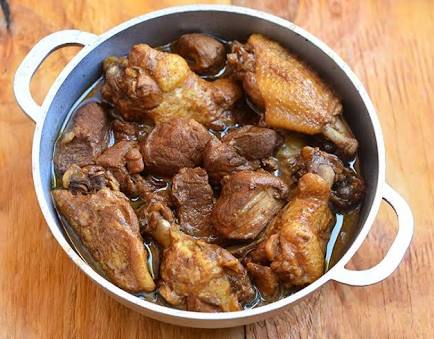
Adobar means to marinade. In the Philippines, it is popularly known as “adobo”. It can be pork adobo,chicken adobo, and the likes. This is one of the best selling dish in the Philippines among foreign and local people.
Adobo or Adobar (Spanish: marinade, sauce, or seasoning) is the immersion of raw food in a stock (or sauce) composed variously of paprika, oregano, salt, garlic, and vinegar to preserve and enhance its flavor. The Portuguese variant is known as Carne de vinha d’alhos.
The practice is native to Iberia, namely Spanish cuisine and Portuguese cuisine. It was widely adopted in Latin America and other Spanish and Portuguese colonies, including the Azores and Madeira.
In the Philippines, the name adobo was given by the Spanish colonists to an indigenous cooking method that also uses vinegar, which, although superficially similar, had developed independently of Spanish influence.
Ingredients
2 lbs pork belly
2 tbsp garlic, minced or crushed
5 pieces dried bay leaves
4 tbsp vinegar
½ cup soy sauce
1 tbsp whole pepper corn
1 cup water
salt to taste
Instructions
Combine the pork belly, soy sauce, and garlic then marinade for at least 1 hour
Heat the pot and put-in the marinated pork belly then cook for a few minutes
Add water, whole pepper corn, and dried bay leaves then bring to a boil. Simmer for 40 minutes to 1 hour
Put-in the vinegar and simmer for 12 to 15 minutes
Add salt to taste
Serve hot. Share and enjoy!
Characteristics
In the years following the discovery of the new world, meat and fish started to be preserved by new methods. Cold temperature facilitated the preservation of food, but the weather often did not provide low temperatures ideal for preservation, so it was necessary to apply other techniques, such as adobo. Animals were usually slaughtered in the coldest months of winter, but surplus meat had to be preserved in the warmer months. This was facilitated through the use of adobos (marinades) along with paprika (a substance with antibacterial properties). Paprika gives a reddish color to adobos and at the same time the capsaicins in paprika permit fats to dissolve to the point of allowing tissue penetration, going deeper than the surface.
Variations
The noun form of adobo describes a marinade or seasoning mix. Recipes vary widely by region: Puerto Rican adobo, a rub used principally on meats, differs greatly from the Mexican variety. Meat marinated or seasoned with an adobo is referred to as adobado or adobada.
Adobo relates to marinated dishes such as chipotles en adobo in which chipotles (smoked ripe jalapeño peppers) are stewed in a sauce with tomatoes, garlic, vinegar, salt, and spices. The spices vary, but generally include several types of peppers (in addition to the chipotle and most likely those on hand), ground cumin and dried oregano. Some recipes include orange juice and lemon or lime juices. They often include a pinch of brown sugar just to offset any bitter taste.
Puerto Rican Edit
Puerto Rican-style adobo is a seasoned salt that is generously sprinkled or rubbed on meats and seafood prior to grilling, sautéing, or frying. Supermarkets sell prepared blends. There are two types of adobo on the island. The wet rub, adobo mojado, consists of crushed garlic, olive oil, salt, black pepper, dry or fresh orégano brujo, citrus juice or vinegar or a mix of both citrus and vinegar. More widely used on the island is a dry mix, adobo seco. It is easier to prepare and has a long shelf life. Adobo seco consists of garlic powder, onion powder, salt, black pepper, dry orégano brujo, and sometimes dried citrus zest.
References
^ Manuel Martinez Llopis (1989), Historia de la gastronomía española, Alianza editorial, ISBN 84-206-0378-3 (Spanish)
^ Susana Aleson, Montse Clavé, (1998), Cocina filipina, ICARIA (Spanish)
^ a b c Ocampo, Ambeth (February 24, 2009). “Looking Back: ‘Adobo’ in many forms”. Philippine Daily Inquirer.
^ a b Paul A. Rodell (2002). Culture and customs of the Philippines. Greenwood Publishing Group. p. 102. ISBN 978-0-313-30415-6.
^ Estrella, Serna (June 22, 2013). “Adobo: The History of A National Favorite”. Pepper.ph. Retrieved March 21, 2016.
^ Hosking, Richard (2006). Authenticity in the Kitchen: Proceedings of the Oxford Symposium on Food and Cookery 2005. Oxford Symposium. p. 299. ISBN 9781903018477.
^ Unai Ugalde, Dani Lasa, Andoni Luis Aduriz, Harold McGee (prólogo) (2009), Las primeras palabras de la cocina, Mugaritz, pp. 114–118 (Spanish)
^ Alan Davidson & Tom Jaine (2006). The Oxford companion to food. Oxford University Press. p. 600. ISBN 978-0-19-280681-9.